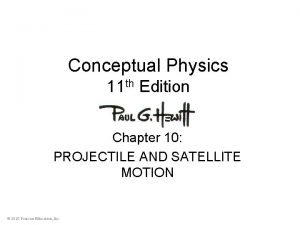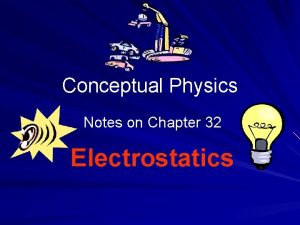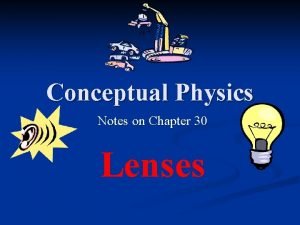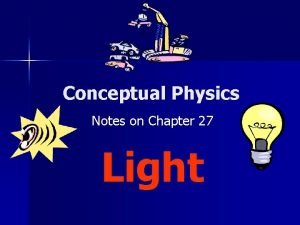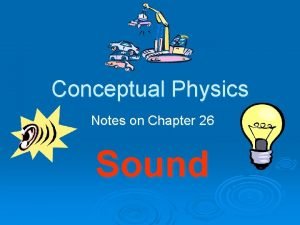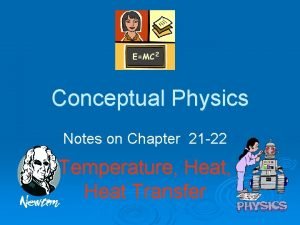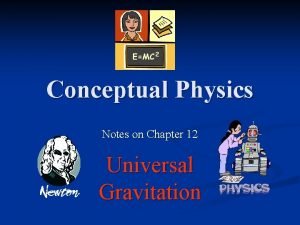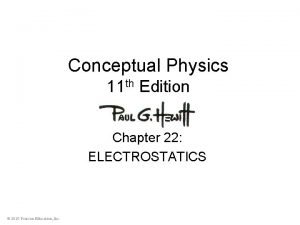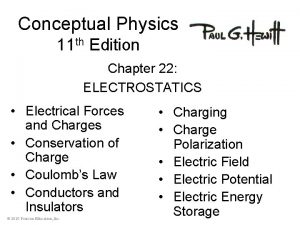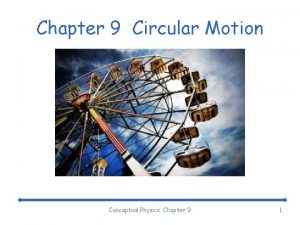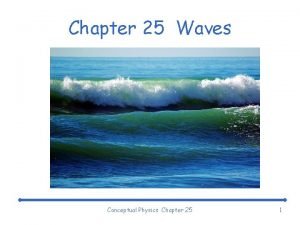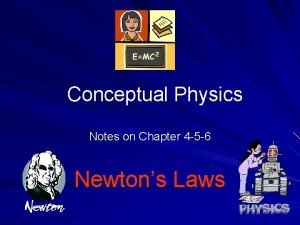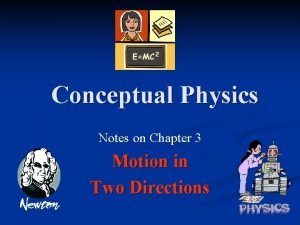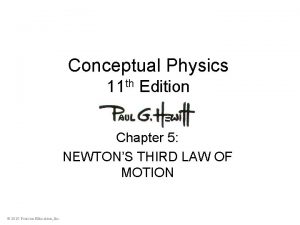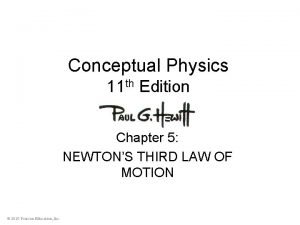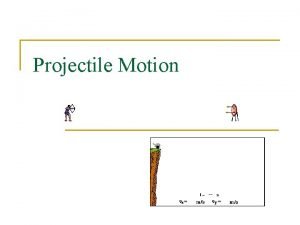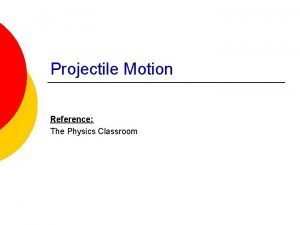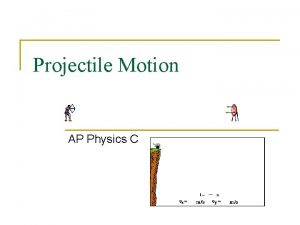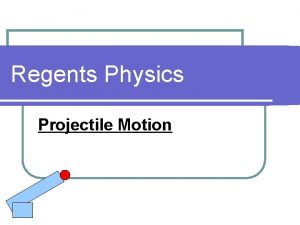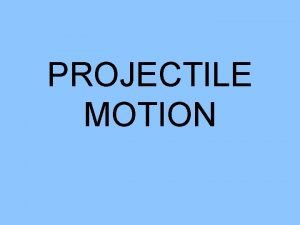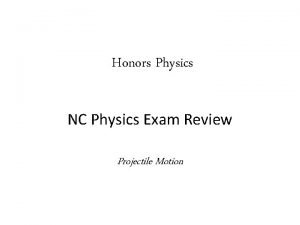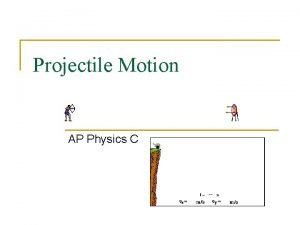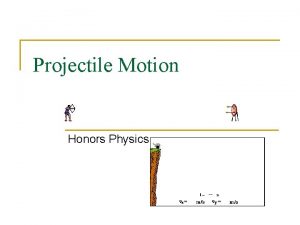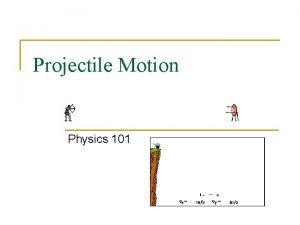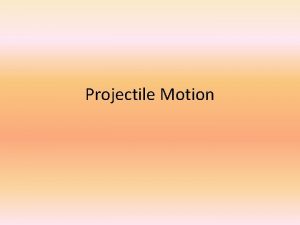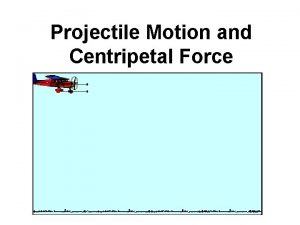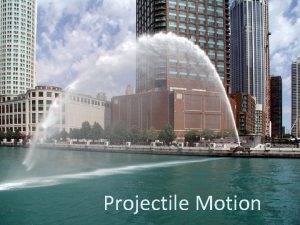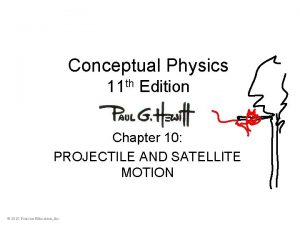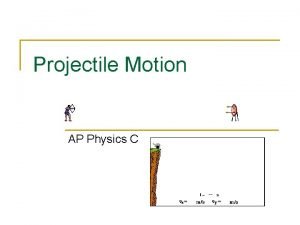Conceptual Physics 11 th Edition Chapter 10 PROJECTILE







































- Slides: 39

Conceptual Physics 11 th Edition Chapter 10: PROJECTILE AND SATELLITE MOTION © 2010 Pearson Education, Inc.

This lecture will help you understand: • • Projectile Motion Fast-Moving Projectiles – Satellites Circular Satellite Orbits Elliptical Orbits Kepler’s Laws of Planetary Motion Energy Conservation and Satellite Motion Escape Speed © 2010 Pearson Education, Inc.

Projectile Motion • Without gravity, a tossed object follows a straight -line path. • With gravity, the same object tossed at an angle follows a curved path. Projectile: • Any object that moves through the air or space under the influence of gravity, continuing in motion by its own inertia © 2010 Pearson Education, Inc.

Projectile Motion Projectile motion is a combination of • a horizontal component, and • a vertical component. © 2010 Pearson Education, Inc.

Projectile Motion Projectiles launched horizontally Important points: Horizontal component of velocity doesn’t change • Ball travels the same horizontal distance in equal times (no component of gravitational force acting horizontally). • Remains constant. © 2010 Pearson Education, Inc.

Projectile Motion • Vertical positions become farther apart with time. – Gravity acts downward, so ball accelerates downward. • Curvature of path is the combination of horizontal and vertical components of motion. © 2010 Pearson Education, Inc.

Projectile Motion Parabmola: • Curved path of a projectile that undergoes acceleration only in the vertical direction, • Acceleration (10 m/s 2 down) • while moving horizontally at a constant speed © 2010 Pearson Education, Inc.

Projectiles launched at an angle: • Paths of stone thrown at an angle upward and downward – Vertical and horizontal components are independent of each other. – How does this change acceleration? © 2010 Pearson Education, Inc.

Projectile Motion • Paths of a cannonball shot at an upward angle © 2010 Pearson Education, Inc.

Projectile Motion Projectiles launched horizontally Important points: Horizontal component of velocity doesn’t change • Ball travels the same horizontal distance in equal times (no component of gravitational force acting horizontally). • Remains constant. © 2010 Pearson Education, Inc.

Projectile Motion • Paths of projectile following a parabolic trajectory – Horizontal component along trajectory remains unchanged. – Only vertical component changes. © 2010 Pearson Education, Inc.

Projectile Motion • Different horizontal distances – Same range is obtained from two different launching angles when the angles add up to 90°. • Object thrown at an angle of 60 has the same range as if it were thrown at an angle of 30. © 2010 Pearson Education, Inc.

Projectile Motion Different horizontal distances (continued) – Maximum range occurs for ideal launch at 45. © 2010 Pearson Education, Inc.

Projectile Motion Without air resistance, the time for a projectile to reach maximum height is the same as the time for it to return to its initial level. © 2010 Pearson Education, Inc.

Projectile Motion CHECK YOUR NEIGHBOR The velocity of a typical projectile launched at some angle. Assuming negligible air resistance, the horizontal component along the path of the projectile A. B. C. increases. decreases. remains the same (HAVEN’T I SAID THIS ENOUGH TIMES). © 2010 Pearson Education, Inc.

Projectile Motion CHECK YOUR NEIGHBOR The velocity of a typical projectile launched at some angle. Assuming negligible air resistance, the vertical component of speed along the path of the projectile A. B. C. D. increases. decreases. constantly changes remains the same (HAVEN’T I SAID THIS ENOUGH TIMES). © 2010 Pearson Education, Inc.

Projectile Motion CHECK YOUR NEIGHBOR When the air resistance on a fast-moving marshmallow is negligible, its acceleration is A. B. g, downward. a combination of constant horizontal motion and accelerated downward motion. C. Depends on its speed. D. centripetal. © 2010 Pearson Education, Inc.

Projectile Motion CHECK YOUR NEIGHBOR Neglecting air drag, a ball tossed at an angle of 30 with the horizontal will go as far downrange as one that is tossed at the same speed at an angle of A. B. C. D. 45. 60. 75. None of the above. © 2010 Pearson Education, Inc.

Fast-Moving Projectiles—Satellites CHECK YOUR NEIGHBOR As the ball leaves the girl’s hand, 1 second later it will have fallen A. B. C. D. 10 meters. 5 meters below the dashed line, (the straight-line path) less than 5 meters below the straight-line path. None of the above. © 2010 Pearson Education, Inc.

Fast-Moving Projectiles—Satellites CHECK YOUR NEIGHBOR As the ball leaves the Chuck Norris's hand (much, very faster), 1 second later it will have fallen A. B. C. D. 10 meters. 5 meters below the dashed line, (the straight-line path) less than 5 meters below the straight-line path. None of the above. © 2010 Pearson Education, Inc.

Fast-Moving Projectiles—Satellites CHECK YOUR NEIGHBOR After the ball has left the girl’s hand, 1 second later, which has the greatest acceleration A B C D they are all the same A © 2010 Pearson Education, Inc. B C

Circular Satellite Orbits Satellite in circular orbit • Speed – must be great enough to ensure that its falling distance matches Earth’s curvature. – is constant—only direction changes. – is unchanged by gravity. © 2010 Pearson Education, Inc.

Circular Satellite Orbits • Positioning: beyond Earth’s atmosphere, where air resistance is almost totally absent Example: Space shuttles are launched to altitudes of 150 kilometers or more, to be above air drag (But even the ISS, as shown experiences some air drag, which is compensated for with periodic upward boosts. ) © 2010 Pearson Education, Inc.

Satellite Orbits Curvature of Earth • Earth surface drops a vertical distance of 5 meters for every 8000 meters tangent to the surface • How fast would the projectile have to be launched? © 2010 Pearson Education, Inc.

Satellite Orbits In one second near Earth an object will fall 5 meters The Earth curves 5 meters “down" about every 8000 meters you go horizontally. Thus if a thing is going 8 km/sec it will fall 5 meters but not get closer to Earth! So Near Earth orbital velocity is about 8000 m/sec. (or 8 km/sec) © 2010 Pearson Education, Inc.

Elliptical Orbits Elliptical orbit (don’t write this… its just cool) • Speed of satellite varies. – Initially, if speed is greater than needed for circular orbit, satellite overshoots a circular path and moves away from Earth. – Satellite loses speed and then regains it as it falls back toward Earth. – It rejoins its original path with the same speed it had initially. – Procedure is repeated. © 2010 Pearson Education, Inc.

Circular Satellite Orbits • Motion moves in a direction perpendicular to the force of gravity acting on it • Period, or the time to complete one cycle, for 1 complete orbit around Earth… • for satellites close to Earth—about 90 minutes • for satellites at higher altitudes—longer periods © 2010 Pearson Education, Inc.

Circular Satellite Orbits Curvature of Earth • Earth surface drops a vertical distance of 5 meters for every 8000 meters tangent to the surface © 2010 Pearson Education, Inc.

Circular Satellite Orbits What speed will allow the ball to clear the gap? © 2010 Pearson Education, Inc.

Circular Satellite Orbits CHECK YOUR NEIGHBOR When you toss a projectile sideways, it curves as it falls. It will be an Earth satellite if the curve it makes A. B. C. D. matches the curved surface of Earth. results in a straight line. spirals out indefinitely. None of the above. © 2010 Pearson Education, Inc.

Circular Satellite Orbits CHECK YOUR ANSWER When you toss a projectile sideways, it curves as it falls. It will be an Earth satellite if the curve it makes A. B. C. D. matches the curved surface of Earth. results in a straight line. spirals out indefinitely. None of the above. Explanation: For an 8 -km tangent, Earth curves downward 5 m. Therefore, a projectile traveling horizontally at 8 km/s will fall 5 m in that time, and follow the curve of Earth. © 2010 Pearson Education, Inc.

Circular Satellite Orbits CHECK YOUR NEIGHBOR When a satellite travels at a constant speed, the shape of its path is A. B. C. D. a circle. an ellipse. an oval that is almost elliptical. a circle with a square corner, as seen throughout your book. © 2010 Pearson Education, Inc.

Circular Satellite Orbits CHECK YOUR ANSWER When a satellite travels at a constant speed, the shape of its path is A. B. C. D. a circle. an ellipse. an oval that is almost elliptical. a circle with a square corner, as seen throughout your book. © 2010 Pearson Education, Inc.

Circular Satellite Orbits A payload into orbit requires control over • direction of rocket. – Initially, rocket is fired vertically, then tipped. – Once above the atmosphere, the rocket is aimed horizontally. • speed of rocket – Payload is given a final thrust to orbital speed of 8 km/s to fall around Earth and become an Earth satellite. © 2010 Pearson Education, Inc.

Elliptical Orbits CHECK YOUR NEIGHBOR The speed of a satellite in an elliptical orbit A. B. C. D. varies. remains constant. acts at right angles to its motion. All of the above. © 2010 Pearson Education, Inc.

Escape Speed First probe to escape the solar system was Pioneer 10, launched from Earth in 1972. • Accomplished by directing the probe into the path of oncoming Jupiter © 2010 Pearson Education, Inc.

Escape Speed CHECK YOUR NEIGHBOR When a projectile achieves escape speed from Earth, it A. B. forever leaves Earth’s gravitational field. outruns the influence of Earth’s gravity, but is never beyond it. C. comes to an eventual stop, returning to Earth at some future time. D. One of the above © 2010 Pearson Education, Inc.

Escape Speed Voyages to the Moon, Mars, and beyond begin with launches that exceed escape speed from Earth. © 2010 Pearson Education, Inc.

Escape Speed Voyages to the Moon, Mars, and beyond begin with launches that exceed escape speed from Earth. © 2010 Pearson Education, Inc.
 Conceptual physics chapter 10
Conceptual physics chapter 10 University physics with modern physics fifteenth edition
University physics with modern physics fifteenth edition Conceptual physics chapter 8
Conceptual physics chapter 8 Conceptual momentum
Conceptual momentum Chapter 35 electric circuits
Chapter 35 electric circuits Conceptual physics chapter 33
Conceptual physics chapter 33 Conceptual physics electrostatics
Conceptual physics electrostatics Chapter 30 conceptual physics
Chapter 30 conceptual physics Chapter 27 light
Chapter 27 light Conceptual physics chapter 26
Conceptual physics chapter 26 Conceptual physics chapter 21
Conceptual physics chapter 21 Conceptual physics chapter 13 universal gravitation
Conceptual physics chapter 13 universal gravitation Conceptual physics chapter 6 momentum
Conceptual physics chapter 6 momentum Conceptual physics chapter 22
Conceptual physics chapter 22 Conceptual physics chapter 22 electrostatics
Conceptual physics chapter 22 electrostatics Circular motion conceptual physics
Circular motion conceptual physics Chapter 25 conceptual physics
Chapter 25 conceptual physics Electricity
Electricity Conceptual physics notes
Conceptual physics notes Conceptual physics chapter 3
Conceptual physics chapter 3 Slightly tilted wings of airplanes deflect
Slightly tilted wings of airplanes deflect Slightly tilted wings of airplanes deflect
Slightly tilted wings of airplanes deflect Conceptual physics chapter 3 linear motion
Conceptual physics chapter 3 linear motion Conceptual physics chapter 17 change of phase answers
Conceptual physics chapter 17 change of phase answers What is vertical velocity
What is vertical velocity Physics classroom
Physics classroom Vy formula physics
Vy formula physics Projectile motion
Projectile motion All formula of projectile motion
All formula of projectile motion Regents physics projectile motion questions
Regents physics projectile motion questions What are two components of projectile motion
What are two components of projectile motion Ap physics projectile motion
Ap physics projectile motion Projectile motion tennis ball
Projectile motion tennis ball Vyi physics
Vyi physics An athlete throws a javelin to a maximum distance of 80m
An athlete throws a javelin to a maximum distance of 80m Mis chapter 6
Mis chapter 6 Zulily case study
Zulily case study When air rapidly expands its temperature normally
When air rapidly expands its temperature normally Conceptual physical science 5th edition
Conceptual physical science 5th edition Conceptual physical science 5th edition
Conceptual physical science 5th edition
